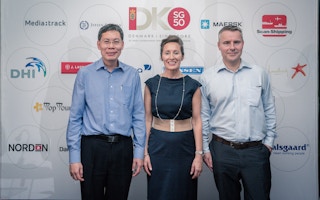Denmark and Singapore are small nations with a tiny population – of about 5.5 million people – and for both, managing scarce resources and reducing their impact on the environment have always been a priority.
To continue reading, subscribe to Eco‑Business.
There's something for everyone. We offer a range of subscription plans.
- Access our stories and receive our Insights Weekly newsletter with the free EB Member plan.
- Unlock unlimited access to our content and archive with EB Circle.
- Publish your content with EB Premium.
Both countries are also open economies, maritime nations with a long tradition of shipping, and have similar ambitions in creating liveable cities for its people.
These make up the foundation of the two nations’ diplomatic relations, which started five decades ago when Singapore became an independent nation. Today, there are more than 300 Danish companies operating in Singapore.
Speaking at a reception to celebrate 50 years of Singapore-Denmark relations on Monday last week, Danish ambassador to Singapore, Berit Basse, said Denmark and Singapore will build on their relationship and collaborate on projects ranging from shipping to urban transport.
The reception on Monday also celebrated the birthday of Denmark’s Queen Margrethe II and was attended by 200 guests.
Ambassador Basse said Denmark and Singapore have benefitted from one another’s experience and skills through bilateral visits, professional exchanges and collaboration on projects in the past five decades.
“
For the next 50 years, I think both Singapore and Denmark, being leaders in smart cities, water technologies and sustainability solutions, will have much more to share and learn from one another.
Berit Basse, Danish Ambassador to Singapore
“In recent years, the collaboration opportunities are being created at an accelerated pace,” she said.
These have included the setting up in Singapore of a Water & Environment Research Centre and Education Hub between Danish water company DHI and Nanyang Technological University in 2007.
In 2014, the Danish Water Technology House was established. It serves as a centre of information and marketing of Danish water technology for Southeast Asia.
Cycling cities
Besides water innovation, cycling is another area that Singapore wants to learn more from Denmark.
Speaking at the same event, Singapore’s minister for transport and second minister for defence Lui Tuck Yew noted that on a visit to the country last year, he was fascinated by how cycling is a primary mode of transport there, instead of just a complement to driving or taking the public transport.
As many as half of the commuters in Copenhagen get around on bicycles. Even in the deepest parts of winter, the Danish cycle tens of kilometres to their destinations, Lui said.
“I am not suggesting that Singaporeans do that, but in terms of providing the infrastructure, the policies and making it a more friendly mode of commute in Singapore, that is something we are going to pick up further from Denmark,” Lui said.
Singapore has plans to make the nation more cycle-friendly, by linking suburbs with cycling-only routes and installing infrastructure such as sheltered or elevated cycling paths.
It is also adding 11,000 bicycle lots at new subway stations, as well as extending a bicycle-sharing pilot - currently rolled out in the towns of Jurong and Marina Bay - to Tampines and Pasir Ris.
He added that Denmark and Singapore are learning from each other the best ways to provide timely and accurate information of public transportation.
For example, both countries are seeking to release more data on bus arrival times and crowdedness of buses to help commuters decide whether to wait for the next bus or walk to their destination, he said.
From shipping to smart cities
Another area that the two countries will collaborate on is shipping, where both countries want to improve on the quality of their shipping sector and maritime training.
Due to increasing competition from other countries with maritime ambitions such as Dubai and Shanghai, there is a pressing need to invest in upgrading the skills of workers in the sector and setting their companies apart by focusing on environmentally-friendly practices.
“We need to strengthen our position by targeting education and green solutions. By doing so in a smart way, we can win the fight to be a leading nation,” said Danish Minister for Business and Growth Henrik Sass Larsen.
Mr Lui also spoke about Singapore’s own goals, which is to increase the capacity of the city’s port – the second-busiest in the world – by about 50 per cent over the next few years
“In the longer term, (we will) almost double it from what it is today because we think that is needed. There are going to be bigger ships - many of them from Denmark. They would need the capacity, the wall space, the cranes and to be able to load and discharge cargo in a very efficient manner,” Lui said.
Ambassador Basse also said Denmark is looking at expanding to new areas of collaboration with Singapore in the next 50 years.
One of these initiatives are electricity-saving smart grids. Launched in 2013 in Denmark by the local government, the smart grid combines electricity meters read on an hourly basis with variable tariffs and a data hub, enabling consumers to use the power when it is least expensive.
“For the next 50 years, I think both Singapore and Denmark, being leaders in smart cities, water technologies and sustainability solutions, will have much more to share and learn from one another.
“This is the space where our industries and think tanks can come together to provide real solutions that the world today needs urgently to solve its challenges and problems,” she added.










